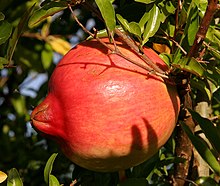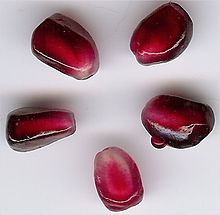Pomegranate
From Wikipedia, the free encyclopedia
For other uses, see Pomegranate (disambiguation).

| Pomegranate Punica granatum | |
|---|---|
| A pomegranate fruit | |
| Scientific classification | |
| Kingdom: | Plantae |
| (unranked): | Angiosperms |
| (unranked): | Eudicots |
| (unranked): | Rosids |
| Order: | Myrtales |
| Family: | Lythraceae |
| Genus: | Punica |
| Species: | P. granatum |
| Binomial name | |
| Punica granatum L. | |
| Synonyms | |
Linnaeus, 1758 | |
The pomegranate pron.: /ˈpɒmɨɡrænɨt/, scientific name Punica granatum, is a fruit-bearing deciduous shrub or small tree growing between 5–8 metres (16–26 ft) tall.
Native to an area from the eastern Mediterranean Basin to India,[1] the pomegranate has been cultivated over millennia, including today throughout the Mediterranean, Middle East and Caucasus regions, northern Africa and tropical Africa, the Indian subcontinent and the drier parts of southeast Asia.[1]Introduced into Latin America and California by Spanish settlers in 1769, pomegranate is also cultivated in parts of California and Arizona.[2]
In the Northern Hemisphere, the fruit is typically in season from September to February.[3] In the Southern Hemisphere, the pomegranate is in season from March to May.
The pomegranate has been mentioned in many ancient texts, notably in Babylonian texts, the Book of Exodus, the Homeric Hymns and the Quran.[4] In recent years, it has become more common in the commercial markets of North America and the Western Hemisphere.[1][2]
Pomegranates are used in cooking, baking, juices, smoothies and alcoholic beverages, such as martinis and wine.[5]
Culinary use
After the pomegranate is opened by scoring it with a knife and breaking it open, the arils (seed casings) are separated from the peel and internal white pulp membranes. Separating the red arils is easier in a bowl of water because the arils sink and the inedible pulp floats. Freezing the entire fruit also makes it easier to separate. Another very effective way of quickly harvesting the arils is to cut the pomegranate in half, score each half of the exterior rind four to six times, hold the pomegranate half over a bowl and smack the rind with a large spoon. The arils should eject from the pomegranate directly into the bowl, leaving only a dozen or more deeply embedded arils to remove.[25]
The entire seed is consumed raw, though the watery, tasty aril is the desired part. The taste differs depending on the subspecies of pomegranate and its ripeness.
The pomegranate juice can be very sweet or sour, but most fruits are moderate in taste, with sour notes from the acidic tannins contained in the aril juice. Pomegranate juice has long been a popular drink in Armenian,Persian and Indian cuisine, and began to be widely distributed in the United States and Canada in 2002.[26]
Grenadine syrup is thickened and sweetened pomegranate juice and is used in cocktail mixing. Before tomatoes (a New World fruit) arrived in the Middle East, grenadine was widely used in many Iranian foods, and is still found in traditional recipes such as fesenjān, a thick sauce made from pomegranate juice and ground walnuts, usually spooned over duck or other poultry and rice, and in ash-e anar(pomegranate soup).[27][28]
Wild pomegranate seeds are used as a spice known as anardana (from Persian: anar + dana, pomegranate + seed), most notably in Indian andPakistani cuisine, but also as a substitute for pomegranate syrup in Persian cuisine. Dried whole arils can often be obtained in ethnic Indian subcontinent markets. These seeds are separated from the flesh, dried for 10–15 days and used as an acidic agent for chutney and curry preparation. Ground anardana is also used, which results in a deeper flavoring in dishes and prevents the seeds from getting stuck in teeth. Seeds of the wild pomegranate variety known as daru from the Himalayas are regarded as quality sources for this spice.
Dried pomegranate arils, found in some natural specialty food markets, still contain the seed and residual aril water, maintaining a natural sweet and tart flavor. Dried arils can be used in several culinary applications, such as trail mix, granola bars, or as a topping for salad, yogurt, or ice cream. Chocolate covered arils may be added to desserts and baked items.
In the Caucasus, pomegranate is used mainly as juice.[29] In Azerbaijan, a sauce from pomegranate juice (narsharab) is usually served with fish[30] ortika kabab. In Turkey, pomegranate sauce (Turkish: nar ekşisi) is used as a salad dressing, to marinate meat, or simply to drink straight. Pomegranate seeds are also used in salads and sometimes as garnish for desserts such as güllaç.[31] Pomegranate syrup or molasses is used in muhammara, a roasted red pepper, walnut, and garlic spread popular in Syria and Turkey.[32]
In Greece, pomegranate (Greek: ρόδι, rodi) is used in many recipes, including kollivozoumi, a creamy broth made from boiled wheat, pomegranates andraisins, legume salad with wheat and pomegranate, traditional Middle Eastern lamb kebabs with pomegranate glaze, pomegranate eggplant relish, andavocado-pomegranate dip. Pomegranate is also made into a liqueur, and as a popular fruit confectionery used as ice cream topping, mixed with yogurt, or spread as jam on toast. In Cyprus and Greece, and among the Greek Orthodox Diaspora, ρόδι (Greek for pomegranate) is used to make koliva, a mixture of wheat, pomegranate seeds, sugar, almonds and other seeds served at memorial services.
In Mexico, they are commonly used to adorn the traditional dish chiles en nogada, representing the red of the Mexican flag in the dish which evokes the green (poblano pepper), white (nogada sauce) and red (pomegranate arils) tricolor.
[edit]In Ayurvedic medicine
In the Indian subcontinent's ancient Ayurveda system of medicine, the pomegranate (Hindi: अनार) has extensively been used as a source of traditional remedies for thousands of years.[33]
The rind of the fruit and the bark of the pomegranate tree is used as a traditional remedy against diarrhea, dysentery and intestinal parasites.[33] The seeds and juice are considered a tonic for the heart and throat, and classified as having bitter-astringent taste plus a range of taste from sweet to sour, depending on ripeneness. Thus Pomegranate is considered a healthful counterbalance to a diet high in sweet-fatty (kapha or earth) components.[34]
Especially when sweet, pomegranate fruit is nourishing for (pitta or fire) systems, particularly the hemopoietic system, and is known as a blood builder. The astringent qualities of the flower juice, rind and tree bark are considered valuable for a variety of purposes, such as stopping nose bleeds and gum bleeds, toning skin, (after blending with mustard oil) firming-up sagging breasts and treating hemorrhoids.[35] Pomegranate juice (of specific fruit strains) is also used as eyedrops as it is believed to slow the development of cataracts.[36]
Ayurveda differentiates between pomegranate varieties and employs them for different remedies.[37]
Pomegranate has been used as a contraceptive and abortifacient by means of consuming the seeds, or rind, as well as by using the rind as a vaginal suppository. This practice is recorded in ancient Indian literature, in Medieval sources, and in modern folk medicine.[38]
[edit]Nutrients and phytochemicals
| Nutritional value per 100 g (3.5 oz) | |
|---|---|
| Energy | 346 kJ (83 kcal) |
| Carbohydrates | 18.7 g |
| - Sugars | 13.67 g |
| - Dietary fiber | 4 g |
| Fat | 1.17 g |
| Protein | 1.67 g |
| Thiamine (vit. B1) | 0.067 mg (6%) |
| Riboflavin (vit. B2) | 0.053 mg (4%) |
| Niacin (vit. B3) | 0.293 mg (2%) |
| Pantothenic acid (B5) | 0.377 mg (8%) |
| Vitamin B6 | 0.075 mg (6%) |
| Folate (vit. B9) | 38 μg (10%) |
| Choline | 7.6 mg (2%) |
| Vitamin C | 10.2 mg (12%) |
| Vitamin E | 0.6 mg (4%) |
| Vitamin K | 16.4 μg (16%) |
| Calcium | 10 mg (1%) |
| Iron | 0.3 mg (2%) |
| Magnesium | 12 mg (3%) |
| Manganese | 0.119 mg (6%) |
| Phosphorus | 36 mg (5%) |
| Potassium | 236 mg (5%) |
| Sodium | 3 mg (0%) |
| Zinc | 0.35 mg (4%) |
| Link to USDA Database entry Percentages are relative to US recommendations for adults. Source: USDA Nutrient Database | |
Pomegranate arils provide 12% of the Daily Value (DV) for vitamin C and 16% DV for vitamin K per 100 g serving, and contain polyphenols, such asellagitannins and flavonoids (section below). Pomegranate arils are excellent sources of dietary fiber which is entirely contained in the edible seeds. People who choose to discard the seeds forfeit nutritional benefits conveyed by the seed fiber and micronutrients.[39][40]
[edit]Phenolic content
The most abundant polyphenols in pomegranate juice are the hydrolyzable tannins called ellagitannins formed when ellagic acid binds with acarbohydrate. Pomegranate ellagitannins, also called punicalagins, are tannins with free-radical scavenging properties in laboratory experiments[41]and with potential human effects.[42] Punicalagins are absorbed into the human body and may have dietary value as antioxidants, but conclusive proof of efficacy in humans has not been shown.[43][44] During intestinal metabolism by bacteria, ellagitannins and punicalagins are converted to urolithins, which have unknown biological activity in vivo.[45][46] The different punicalagins present in P. granatum are granatin A and B, punicacortein A, B, Cand D, 5-O-galloylpunicacortein D, punicafolin, punigluconin, punicalagin, 1-alpha-O-galloylpunicalagin, punicalin and 2-O-galloyl-punicalin.[citation needed] Other phenolics include catechins, gallocatechins, and anthocyanins, such as prodelphinidins, delphinidin, cyanidin, andpelargonidin.[47]
Many food and dietary supplement makers use pomegranate phenolic extracts as ingredients in their products instead of the juice. One of these extracts is ellagic acid, which may become bioavailable only after parent molecule punicalagins are metabolized. However, ingested ellagic acid from pomegranate juice does not accumulate in the blood in significant quantities and is rapidly excreted.[48] Accordingly, ellagic acid from pomegranate juice does not appear to be biologically important in vivo.
[edit]Potential health benefits
In preliminary laboratory research and clinical trials, juice of the pomegranate may be effective in reducingheart disease risk factors, including LDL oxidation, macrophage oxidative status, and foam cellformation.[49][50][51] In mice, "oxidation of LDL by peritoneal macrophages was reduced by up to 90% after pomegranate juice consumption...".[52]
In a limited study of hypertensive patients, consumption of pomegranate juice for two weeks was shown to reduce systolic blood pressure by inhibiting serum angiotensin-converting enzyme.[53] Juice consumption may also inhibit viral infections[54] while pomegranate extracts have antibacterial effects against dental plaque.[55]
Despite limited research data, manufacturers and marketers of pomegranate juice have liberally used evolving research results for product promotion, especially for putative antioxidant health benefits. In February 2010, the FDA issued a Warning Letter to one such manufacturer, POM Wonderful, for using published literature to make illegal claims of unproven antioxidant and anti-disease benefits.[56][57][58]
[edit]Clinical trial rationale and activity
Metabolites of pomegranate juice ellagitannins localize specifically in the prostate gland, colon, and intestinal tissues of mice,[59] leading to clinical studies of pomegranate juice or fruit extracts for efficacy against several diseases.
In 2011, 32 clinical trials were registered with the National Institutes of Health to examine effects of pomegranate extracts or juice consumption on a list of diseases:[60]







No comments:
Post a Comment